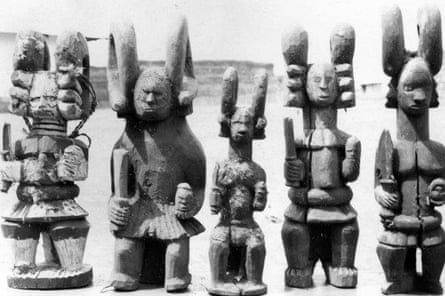A prominent Igbo-Nigerian artist and academic has called for the cancellation of a forthcoming auction in Paris of two sacred sculptures taken out of Nigeria during its devastating civil war in the late 1960s.
Chika Okeke-Agulu, a professor of art history at Princeton University, said the sale of the Igbo objects – called alusi or “sacred sculptures” – at Christie’s auction house later this month would “perpetuate the violence” of the conflict.

Similar sculptures that adorned Igbo shrines in Okeke-Agulu’s hometown and across south-east Nigeria were taken during the failed push for an independent state of Biafra. Up to 3 million people died, many from starvation, during the conflict, one of the darkest chapters in modern history.
“The original acquisition was rooted in violence,” Okeke-Agulu said in an interview. “These objects are from my hometown, removed from places around eastern Nigeria during that war. What we’re seeing now is the continuing benefit from that original act of violence, which is an extension of that violence.”
The sculptures, which have an estimated sale price of between €250,000 and €350,0000 (£227,000-£317,000), were acquired from Nigeria by the prolific French art collector Jacques Kerchache.
Countless alusi sculptures were systematically looted during the war from Mbari houses – communal shrines lined with symbolic murals and sculptures of Igbo deities.
Many artefacts were taken from Okeke-Agulu’s home state of Anambra, the frontline of the war in the majority Igbo south-east of Nigeria. As the conflict raged, local conspirators collaborating with wealthy benefactors engineered the exodus of cultural treasures across the border to Cameroon.
“I remember there was deep pain at what the war cost us when it was over,” he said. “I still remember my mother looking through catalogues in the 70s of alusis and important cultural artefacts, most of which were outside of Nigeria.

“As an art historian it is a continuing agony that I teach African art. I studied African art at the University of Nigeria in Nsukka and we did not have access to the key artistic monuments of Igbo or Yoruba art..”
According to Christie’s, the sculptures were acquired by Kerchache between 1968-69, likely through a Belgian dealer, Phillipe Guimiot, and other local art dealers. “There is no evidence these statues were removed from their original location by someone who was not local to the area,” Christie’s said in a statement. “At no stage since they have been widely known has there been any suggestion that these statues were subject to improper export.”
Nigeria’s 1953 Antiquities Ordinance law made the trade of stolen cultural artefacts illegal, and a 1970 Unesco convention signed by Nigeria banned the international trade in stolen artefacts.
The alusi statues are among a vast collection amassed by Kechache and sold to a private collector after his death in 2001. Kechache, who advised the late French president Jacques Chirac, was a prominent art figure and helped to found the Musée du Quai Branly-Jacques Chirac in Paris.

Okeke-Agulu said Kerchache was a key player in the global market for cultural artefacts who exploited Nigeria’s war.
“It does not matter whether Jacques braved the bullets and bombs, went by foot into Biafra and carted away or seized these objects. The main issue is that in a place that was at war, people went in and took away valuable materials of artistic and cultural value and sold them,” he said.
Beginning with a rallying Instagram post earlier this month, Okeke-Agulugu has spurred growing awareness of the statues’ origins and opposition to the sale.
The loss of cultural objects during the war was immense. Anna Craven worked as an ethnographer and curator at the Nigerian Federal Department of Antiquities in Jos, central Nigeria. In 1970, she was present during a raid where Cameroonian traders were stopped with dozens of cultural artefacts.
“There’s been a huge international market for antiquities, particularly Nigerian antiquities, she said. “It sadly continues today.”
In the wake of the death of George Floyd in Minneapolis, Black Lives Matter demonstrations have refocused the spotlight on the colonial origins of cultural artefacts in the possession of western art institutions and collectors.
Earlier this month, five protesters who tried and failed to seize an African funeral pole from the Musée du Quai Branly-Jacques Chirac said “most of the works [in the museum] were taken during colonialism and we want justice”.
Calls for the repatriation of artefacts taken out of Africa in the colonial era have grown more vigorous in recent years, resulting in unprecedented pressure on western galleries and institutions. Yet in practice repatriations have not been radical.
The Benin Dialogue Group is evaluating a proposal for hundreds of Benin bronzes to return to Nigeria in a new gallery to be built by 2023 in Benin City. Most were stolen during violent raids by British soldiers in 1897 and could be loaned back for an initial three years.
The conditions for such returns are often perverse, said Okeke-Agulu. “It is like someone stealing your car and then agreeing to return it when they are satisfied with the condition of your garage,” he said.
He hopes that increased awareness will help move the dial. “What they [auction houses] care about is their brand. The campaign is important because we are making it unavoidable that these items can’t be divorced from their dispossession. Christie’s and other companies have to reckon with that.”
